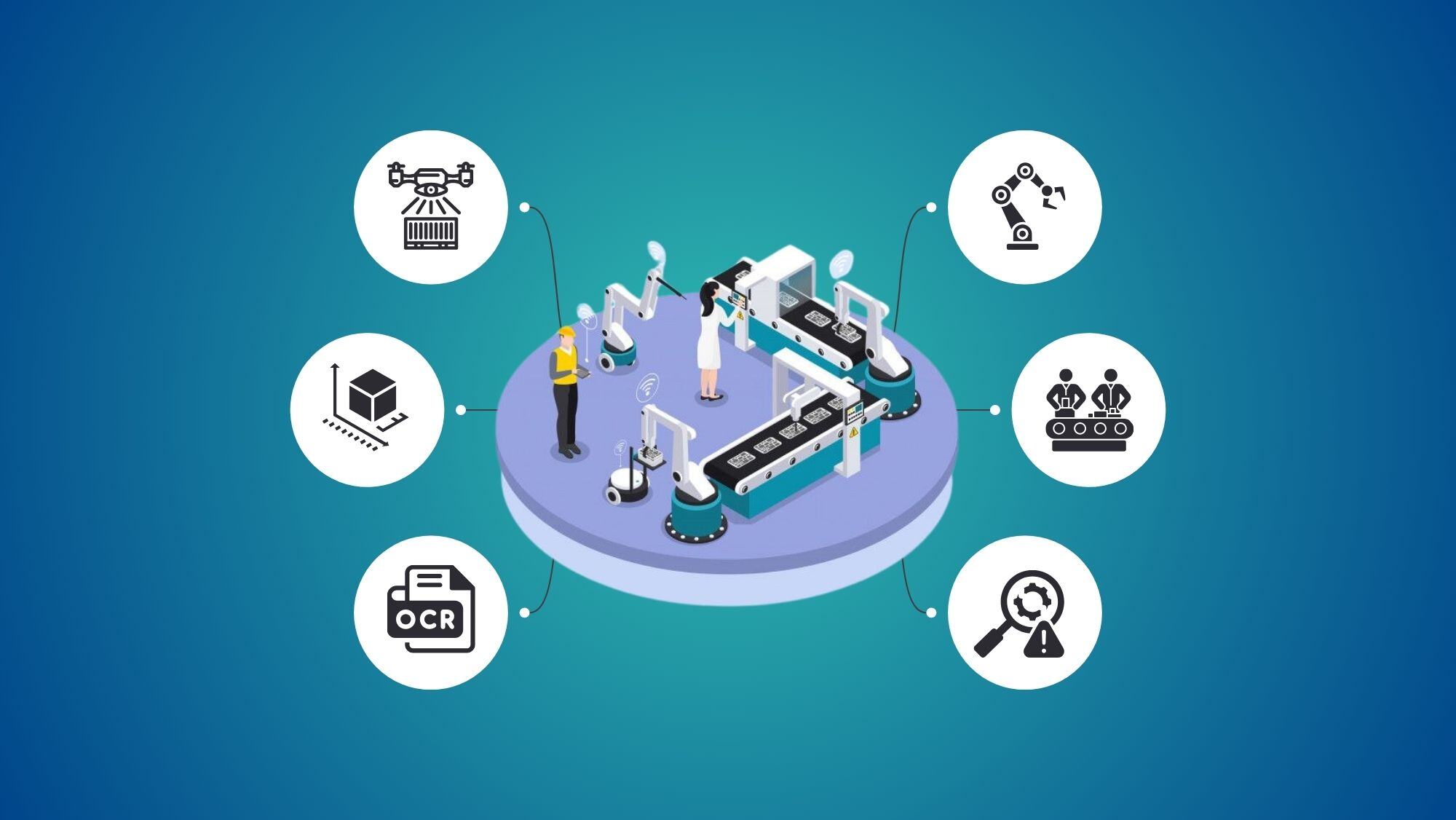In the modern manufacturing landscape, Industry 4.0 is ushering in a new era of smart factories, driven by the integration of digital technologies and automation. Among the key technologies revolutionizing these factories are vision control systems (also known as machine vision systems). These systems enable machines to "see" and make intelligent decisions based on visual input, playing a pivotal role in automating inspection, quality control, and production processes.
In this blog, we’ll explore the top applications of vision control systems in Industry 4.0 and how they are shaping the future of manufacturing, from inspection tasks to full-scale automation.
What are Vision Control Systems?
Vision control systems are sophisticated setups that include cameras, sensors, image processing software, and control units that allow machines to interpret visual information and make decisions accordingly. These systems simulate human vision but go beyond human capabilities, providing high precision, speed, and reliability.
The integration of machine learning (ML) and artificial intelligence (AI) has further enhanced the capabilities of vision systems, enabling them to identify patterns, detect anomalies, and even predict potential issues before they occur.
The Role of Vision Control Systems in Industry 4.0
Industry 4.0, also known as the Fourth Industrial Revolution, represents the shift toward connected and intelligent production systems. It combines automation, data exchange, and smart technologies like the Internet of Things (IoT), AI, and cyber-physical systems. Vision control systems are integral to this revolution as they enable automated visual inspection, adaptive manufacturing, and autonomous decision-making, all while reducing costs and increasing productivity.
Now, let’s look at the top applications of vision control systems across different industrial domains.
1. Automated Inspection and Quality Control
Perhaps the most prevalent application of vision control systems is in automated inspection and quality control. Traditionally, human operators were tasked with visually inspecting products for defects, which could be time-consuming and prone to human error. However, vision systems provide a solution that allows manufacturers to inspect products with incredible speed and accuracy, without the need for human intervention.
Key Features:
- Real-Time Detection: Vision systems can detect defects such as scratches, dents, misalignments, and more in real-time. These systems can inspect thousands of parts per minute, far beyond what human inspectors can handle.
- Consistency: Unlike humans, vision systems do not suffer from fatigue, ensuring consistent inspection quality across long production runs.
- Defect Categorization: Machine vision can not only detect a defect but also classify and categorize different types of defects, which helps manufacturers identify the root cause of production issues.
Example: In pharmaceutical manufacturing, vision systems are used to inspect tablets and capsules for size, color, and shape, ensuring compliance with quality standards. In the automotive industry, vision systems inspect every car part for structural integrity, ensuring defect-free assembly.
2. Robotic Guidance and Automation
In the realm of robotic automation, vision control systems play a critical role in guiding robots for precise tasks such as pick-and-place operations, assembly, and material handling. Robots that are integrated with vision control systems are equipped with "eyes" that allow them to detect, locate, and interact with objects in their environment with high precision.
Key Features:
- 3D Object Recognition: Advanced vision systems are capable of recognizing objects in three dimensions, enabling robots to handle objects of varying shapes and sizes.
- Adaptive Gripping: Vision systems allow robots to adjust their grip based on the object’s orientation and placement, making them suitable for handling delicate components.
- Real-Time Adjustments: Vision systems enable real-time adjustments, allowing robots to account for environmental changes, such as slight shifts in the position of objects on a conveyor belt.
Example: In electronics manufacturing, robots equipped with vision systems assemble printed circuit boards (PCBs) by identifying the exact placement of components. In the logistics industry, robots use vision systems to sort packages based on barcodes or labels, facilitating fast and accurate delivery.
3. Assembly Verification
Vision control systems are widely used in assembly lines to verify that parts have been correctly assembled. These systems ensure that each component is in the right position and orientation before the product moves to the next stage of production. This capability is crucial in industries where small errors in assembly can lead to significant problems down the line.
Key Features:
- Component Presence Detection: Vision systems can verify that all required components are present in an assembly.
- Alignment Verification: They check that parts are properly aligned, which is particularly useful in complex assemblies like electronic devices or engines.
- Process Feedback: The system provides feedback to other machines, enabling automatic corrections when misalignments or missing components are detected.
Example: In aerospace manufacturing, vision systems are used to inspect the correct assembly of critical components like turbines and avionics systems, where precision is vital for safety and performance. Similarly, in consumer electronics, vision systems ensure that connectors and circuits are properly aligned in smartphones.
4. Dimensional Measurement and Gauging
Vision control systems are also employed for precision measurement and dimensional gauging of components. This application is crucial in industries that require parts to be manufactured within tight tolerances, where even minor deviations can lead to malfunctions or failures.
Key Features:
- Non-Contact Measurement: Vision systems can measure the dimensions of parts without making contact, which is essential for fragile or sensitive components.
- High-Speed Measurement: These systems perform measurements at high speeds, making them suitable for continuous production lines.
- Sub-Micron Precision: Modern vision systems offer sub-micron accuracy, allowing them to measure very small parts with extreme precision.
Example: In the automotive industry, vision control systems are used to measure engine components, ensuring they meet the exact specifications required for performance and safety. In semiconductor manufacturing, vision systems measure tiny chips and circuits to ensure they meet stringent dimensional tolerances.
5. Barcode and Optical Character Recognition (OCR)
Vision control systems are frequently used for barcode reading and Optical Character Recognition (OCR) in manufacturing, packaging, and logistics. These systems help automate the tracking and identification of products, components, and packages.
Key Features:
- High-Speed Scanning: Vision systems can scan barcodes and read text at very high speeds, making them ideal for fast-moving production and packaging lines.
- Multi-Format Support: They support various barcode types (e.g., 1D, 2D) and OCR applications, enabling accurate reading regardless of format.
- Error Detection: These systems detect missing or incorrect barcodes and text, ensuring accurate labeling and tracking.
Example: In the food and beverage industry, vision systems ensure that expiration dates and batch numbers are correctly printed on packaging. In logistics, they scan shipping labels to facilitate sorting and delivery processes in large distribution centers.
6. Surface and Defect Inspection
Beyond assembly verification, vision control systems can be specifically tailored to inspect the surfaces of products for defects. Surface inspection is vital in industries where visual appearance is a key indicator of quality.
Key Features:
- Surface Texture Analysis: Vision systems can analyze surface textures for inconsistencies, such as scratches, dents, or discoloration.
- Reflective and Transparent Material Handling: Advanced systems are capable of inspecting reflective or transparent materials, such as glass or polished metal, which present challenges for traditional vision systems.
- High-Resolution Imaging: The systems offer high-resolution imaging to detect even microscopic defects on the surface of products.
Example: In the automotive industry, vision systems inspect the paint finish on vehicles, ensuring that the surface is smooth and free of defects. In the glass manufacturing industry, these systems check for cracks or bubbles that could compromise the product’s integrity.
Emerging Trends in Vision Control Systems
As Industry 4.0 continues to evolve, vision control systems are integrating newer technologies that expand their capabilities:
- AI and Machine Learning: AI-powered vision systems are becoming more capable of recognizing patterns, detecting anomalies, and learning from past data, making them more autonomous and efficient.
- 3D Vision: As vision systems evolve from 2D to 3D, they can capture depth information, enabling more complex applications like robotic picking in cluttered environments or in-depth inspection of intricate parts.
- Edge Computing: With edge computing, data from vision systems is processed closer to where it is generated, reducing latency and enabling real-time decision-making.
- Cloud Integration: Vision control systems are increasingly connected to cloud platforms, where data is analyzed and used to inform broader factory operations, improving overall productivity and efficiency.
Conclusion
Vision control systems are at the heart of the automation revolution in Industry 4.0. By enabling machines to "see" and interpret visual data, these systems are transforming industries, from quality control and robotic guidance to measurement and surface inspection. As technology advances, vision control systems will become even more integral to manufacturing, driving higher efficiency, accuracy, and adaptability in smart factories.
With applications ranging from simple barcode scanning to complex 3D object recognition, vision control systems are helping manufacturers meet the growing demands for automation, precision, and scalability. Their role in shaping the future of manufacturing cannot be overstated, as they continue to drive innovation and unlock new possibilities in the world of smart production.








No Comments Yet
Let us know what you think